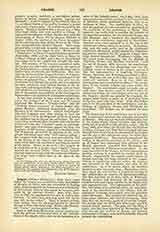

Lay Abbot (abbatocomes, abbas laicus, abbas miles), a name used to designate a layman on whom a king or someone in authority bestowed an abbey as a reward for services rendered; he had charge of the estate belonging to it, and was entitled to part of the income. This baneful custom had a bad effect upon the life of the cloister. It existed principally in the Frankish Empire from the eighth century till the ecclesiastical reforms of the eleventh. Charles Martel (q.v.) was the first to bestow extensive ecclesiastical property upon laymen, political friends, and warriors who had helped him in his campaigns. At an earlier period the French Merovingians had bestowed church lands on laymen, or at least allowed them their possession and use, though not ownership. Numerous synods held in France in the sixth and seventh centuries passed decrees against this abuse of church property. The French kings were also in the habit of appointing abbots to monasteries which they had founded; moreover, many monasteries, though not founded by the king, placed themselves under royal patronage in order to share his protection, and so became possessions of the Crown. This custom of the Merovingian rulers of disposing of church property in individual cases, as also that of appointing abbots to monasteries founded by or belonging to themselves, was taken as a precedent by the French kings for rewarding laymen with abbeys, or giving them to bishops in commendam. Under Charles Martel the Church was greatly injured by this abuse, not only in her possessions, but also in her religious life. St. Boniface and later Hincmar of Reims picture most dismally the consequent downfall of church discipline, and though St. Boniface tried zealously and even successfully to reform the Frankish Church, the bestowal of abbeys on secular abbots was not entirely abolished. Under Pepin the monks were permitted, in case their abbey should fall into secular hands, to go over to another community.
Charlemagne also frequently gave church property, and sometimes abbeys, in feudal tenure. It is true that Louis the Pious aided St. Benedict of Aniane in his endeavors to reform the monastic life. In order to accomplish this it was necessary to restore the free election of abbots, and the appointment as well of blameless monks as heads of the monastic houses. Although Emperor Louis shared these principles, he continued to bestow abbeys on laymen, and his sons imitated him. The important Abbey of St. Riquier (Centula) in Picardy had secular abbots from the time of Charlemagne, who had given it to his friend Angilbert, the poet and the lover of his daughter Bertha, and father of her two sons (see Angilbert, Saint ). After Angilbert’s death in 814, the abbey was given to other laymen. Under such influences the Church was bound to suffer; frequently the abbeys were scenes of worldliness and revelry. Various synods of the ninth century passed decrees against this custom; the Synod of Diedenhofen (October, 844) decreed in its third canon, that abbeys should no longer remain in the power of laymen, but that monks should be their abbots (Hefele, “Konziliengeschichte”, 2nd ed., IV, 110). In like manner the Synods of Meaux and Paris (845-846) complained that the monasteries held by laymen had fallen into decay, and emphasized the king’s duty in this respect (op. cit., IV, 115). But abbeys continued to be bestowed upon laymen especially in France and Lorraine, e.g. St. Evre near Toul, in the reign of Lothaire I. Lothaire II, however, restored it to ecclesiastical control in 858, but the same king gave Bonmoutier to a layman; and the Abbeys of St. Germain and St. Martin, in the Diocese of Toul, were also given to secular abbots. In the Diocese of Metz, the Abbey of Gorze was long in the hands of laymen, and under them fell into decay. Stavelot and Malmedy, in the Diocese of Liege, were in the eleventh century bestowed on a certain Count Raginarius, as also St. Maximin near Trier on a Count Adalhard, etc. (Hauck, “Kirchengeschichte Deutschland”, II, 598). In 888 a Synod of Mainz decreed (can. xxv) that the secular abbots should place able provosts and provisory over their monasteries.
Councils, however, were unable to put an end to the evil; in a synod held at Trosly, in the Diocese of Soissons, in 909, sharp complaints were made (ch. iii) about the lives of monks; many convents, it was said, were governed by laymen, whose wives and children, soldiers and dogs, were housed in the precincts of the religious. To better these conditions it was necessary, the synod declared, to restore the regular abbots and abbesses; at the same time ecclesiastical canons and royal capitularies declared laymen quite devoid of authority in church affairs (Hefele, op. cit., IV, 572-73). Lay abbots existed in the tenth century, also in the eleventh. Gosfred, Duke of Aquitaine, was Abbot of the monastery of St. Hilary, at Poitiers, and as such he published the decrees issued (1078) at the Synod of Poitiers (Hefele, op. cit., V, 116). It was only through the so-called investitures conflict that the Church was freed from secular domination; the reform of religious and ecclesiastical life brought about by the papacy, put an end to the bestowal of abbeys upon laymen.
J. P. KIRSCH

